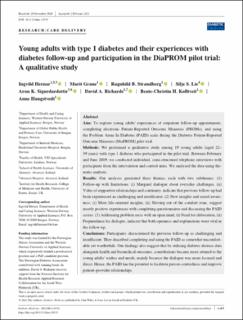| dc.contributor.author | Graue, Marit | |
| dc.contributor.author | Strandberg, Ragnhild Bjarkøy | |
| dc.contributor.author | Lie, Silje Stangeland | |
| dc.contributor.author | Sigurdardottir, Árún K. | |
| dc.contributor.author | Richards, David A | |
| dc.contributor.author | Kolltveit, Beate-Christin Hope | |
| dc.contributor.author | Haugstvedt, Anne | |
| dc.coverage.spatial | Norway | en_US |
| dc.date.accessioned | 2021-02-19T12:16:09Z | |
| dc.date.available | 2021-02-19T12:16:09Z | |
| dc.date.created | 2021-02-16T16:53:55Z | |
| dc.date.issued | 2021 | |
| dc.identifier.citation | Hernar, I., Graue, M., Strandberg, R. B., Lie, S. S., Sigurdardottir, A. K., Richards, D. A., Kolltveit, B. C. H., & Haugstvedt, A. (2021). Young adults with type 1 diabetes and their experiences with diabetes follow‐up and participation in the DiaPROM pilot trial: A qualitative study. Diabetic Medicine. | en_US |
| dc.identifier.issn | 0742-3071 | |
| dc.identifier.uri | https://hdl.handle.net/11250/2729230 | |
| dc.description.abstract | Aim
To explore young adults' experiences of outpatient follow‐up appointments, completing electronic Patient‐Reported Outcome Measures (PROMs), and using the Problem Areas In Diabetes (PAID) scale during the Diabetes Patient‐Reported Outcome Measures (DiaPROM) pilot trial.
Methods
We performed a qualitative study among 19 young adults (aged 22–39 years) with type 1 diabetes who participated in the pilot trial. Between February and June 2019, we conducted individual, semi‐structured telephone interviews with participants from the intervention and control arms. We analysed the data using thematic analysis.
Results
Our analyses generated three themes, each with two subthemes: (1) Follow‐up with limitations; (i) Marginal dialogue about everyday challenges, (ii) Value of supportive relationships and continuity, indicate that previous follow‐up had been experienced as challenging and insufficient. (2) New insights and raised awareness; (i) More life‐oriented insights, (ii) Moving out of the comfort zone, suggest mostly positive experiences with completing questionnaires and discussing the PAID scores. (3) Addressing problem areas with an open mind; (i) Need for elaboration, (ii) Preparedness for dialogue, indicate that both openness and explanations were vital in the follow‐up.
Conclusions
Participants characterised the previous follow‐up as challenging and insufficient. They described completing and using the PAID as somewhat uncomfortable yet worthwhile. Our findings also suggest that by utilising diabetes distress data alongside health and biomedical outcomes, consultations became more attuned to the young adults' wishes and needs, mainly because the dialogue was more focused and direct. Hence, the PAID has the potential to facilitate person‐centredness and improve patient–provider relationships. | en_US |
| dc.language.iso | eng | en_US |
| dc.publisher | Wiley | en_US |
| dc.rights | Navngivelse 4.0 Internasjonal | * |
| dc.rights.uri | http://creativecommons.org/licenses/by/4.0/deed.no | * |
| dc.subject | diabetes mellitus | en_US |
| dc.subject | empowerment | en_US |
| dc.subject | outpatient care | en_US |
| dc.subject | patient-centred care | en_US |
| dc.subject | professional–patient relations | en_US |
| dc.subject | self report | en_US |
| dc.subject | type 1 adult | en_US |
| dc.title | Young adults with type 1 diabetes and their experiences with diabetes follow‐up and participation in the DiaPROM pilot trial: A qualitative study | en_US |
| dc.type | Peer reviewed | en_US |
| dc.type | Journal article | en_US |
| dc.description.version | publishedVersion | en_US |
| dc.rights.holder | © 2021 The Authors | en_US |
| dc.source.journal | Diabetic Medicine | en_US |
| dc.identifier.doi | 10.1111/dme.14535 | |
| dc.identifier.cristin | 1890555 | |
| cristin.ispublished | true | |
| cristin.fulltext | original | |
| cristin.qualitycode | 1 | |

